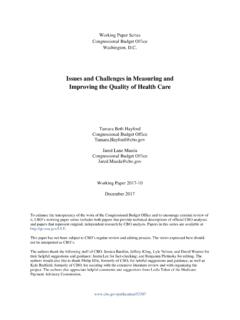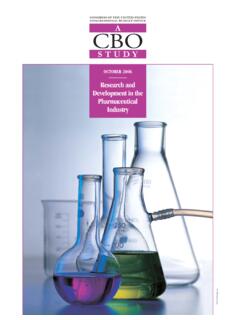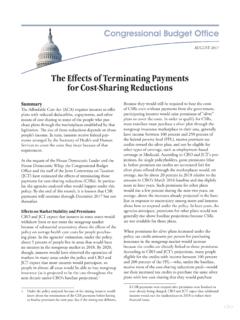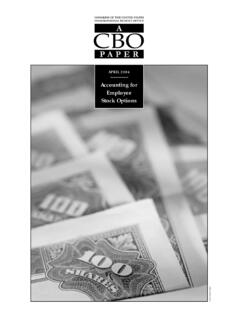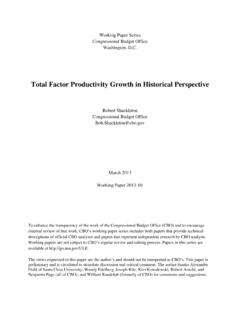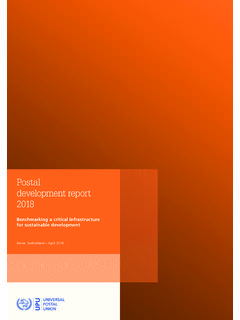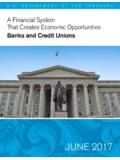Transcription of Estimated Impact of the American Recovery and …
1 CBOCONGRESSIONAL budget OFFICESECOND AND D STREETS, , 20515 Estimated Impact of the American Recovery and Reinvestment Act on Employment and Economic Output from October 2011 Through December 2011 February 2012 Pub. No. 4435 The Congress of the United States O congressional budget OfficeAREPORTCBOE stimated Impact of the American Recovery and Reinvestment Act on Employment and Economic Output from October 2011 Through December 2011 February 2012 PrefaceCBOThe American Recovery and Reinvestment Act of 2009 (ARRA) contains provisions that are intended to boost economic activity and employment in the United States. Section 1512(e) of the law requires the congressional budget office (CBO) to comment on reports filed by recipients of ARRA funding that detail the number of jobs funded through their activities. This CBO report fulfills that requirement. It also provides CBO s estimates of ARRA s overall Impact on employment and economic output in the fourth quarter of calendar year 2011, as well as over the entire period since February 2009.
2 Those estimates which CBO considers more comprehensive than the recipients reports are based on evidence from similar policies enacted in the past and on the results of various economic Reichling of CBO s Macroeconomic Analysis Division wrote the report under the supervision of Wendy Edelberg and William Randolph. Jared Brewster, Mark Lasky, Benjamin Page, and Joshua Shakin contributed to the analysis. John Skeen edited the report , and Jeanine Rees prepared it for publication, Monte Ruffin printed it, and Linda Schimmel handled the distribution. This report , along with previous reports on the topic, is available on CBO s Web site ( ).Douglas W. ElmendorfDirectorFebruary 2012 ContentsCBOM easuring ARRA s Impact Using Recipients Reports2 Measuring ARRA s Impact Using Economic Models and Historical Data4 CBO s Modeling Approach5 Changes from CBO s Previous Estimates of the Impact of ARRA8 ARRA s Long-Run Effects8 Appendix: Evidence on the Economic Effects of Fiscal Stimulus11 Tables1.
3 Estimated Macroeconomic Impact of the American Recovery and Reinvestment Act, 2009 to 201332. Estimated Output Multipliers of Major Provisions of the American Recovery and Reinvestment Act of 20096 CBOE stimated Impact of the American Recovery and Reinvestment Act on Employment and Economic Output from October 2011 Through December 2011In February 2009, in response to significant weakness in the economy, lawmakers enacted the American Recov-ery and Reinvestment Act (ARRA). The legislation s numerous spending and revenue provisions can be grouped into several categories according to their focus Providing funds to states and localities for example, by raising federal matching rates under Medicaid, providing aid for education, and increasing financial support for some transportation projects; Supporting people in need such as by extending and expanding unemployment benefits and increasing benefits under the Supplemental Nutrition Assistance Program (formerly the Food Stamp program); Purchasing goods and services for instance, by fund-ing construction and other investment activities that could take several years to complete.
4 And Providing temporary tax relief for individuals and businesses such as by raising exemption amounts for the alternative minimum tax, adding a new Making Work Pay tax credit, and creating enhanced deduc-tions for depreciation of business ARRA was being considered, the congressional budget office (CBO) and the staff of the Joint Commit-tee on Taxation Estimated that it would increase budget deficits by $787 billion between fiscal years 2009 and 2019. CBO now estimates that the total Impact over the 2009 2019 period will amount to about $831 billion. By CBO s estimate, close to half of that Impact occurred in fiscal year 2010, and more than 90 percent of ARRA s budgetary Impact was realized by the end of December recipients of ARRA funds (most recipients of grants and loans, contractors, and subcontractors) are required to report , after the end of each calendar quarter, the number of jobs funded through ARRA.
5 The law also requires CBO to comment on those reported the fourth quarter of calendar year 2011, recipients reported, ARRA funded more than 200,000 full-time-equivalent (FTE) Those reports, however, do not provide a comprehensive estimate of the law s Impact on employment, which could be higher or lower than the number of FTE jobs reported, for several reasons (in addition to any issues concerning the quality of the reports data).3 First, some of the jobs included in 1. Public Law 111-5, sections 1512(c) and 1512(e); 123 Stat. 115, 288. This report is the 10th in CBO s series of quarterly reports. For the previous report , see congressional budget office , Estimated Impact of the American Recovery and Reinvestment Act on Employment and Economic Output from July 2011 Through September 2011 (November 2011). 2. Data compiled from recipients reports (on jobs funded and other information) are shown at Recipients were asked to calculate FTEs by taking the total number of hours worked in a quarter that were funded by ARRA and dividing the total by the number of hours that a full-time employee would have worked in that For a discussion of data quality, see Government Accountability office , Recovery Act: Opportunities to Improve Management and Strengthen Accountability over States and Localities Uses of Funds, GAO-10-999 (September 2010), 2 Estimated Impact OF ARRA ON EMPLOYMENT AND ECONOMIC OUTPUT FROM OCTOBER 2011 THROUGH DECEMBER 2011 CBOthe reports might have existed even without the stimulus package, with employees working on the same activities or other activities.
6 Second, the reports cover employers that received ARRA funding directly and those employ-ers immediate subcontractors (the so-called primary and secondary recipients of ARRA funding) but not lower-level subcontractors. Third, the reports do not attempt to measure the number of jobs that were created or retained indirectly as a result of recipients increased income, and the increased income of their employees, which could boost demand for other products and ser-vices as they spent their paychecks. Fourth, the recipients reports cover only certain ARRA appropriations, which encompass about one-fifth of the total either spent by the government or conveyed through tax reductions in ARRA; the reports do not measure the effects of other provisions of the stimulus package, such as tax cuts and transfer payments (including unemployment insurance payments) to individual people. Estimating the law s overall effects on employment requires a more comprehensive analysis than can be achieved by using the recipients reports.
7 Therefore, look-ing at recorded spending to date along with estimates of the other effects of ARRA on spending and revenues, CBO has Estimated the law s Impact on employment and economic output using evidence about the effects of previous similar policies and drawing on various mathematical models that represent the workings of the economy. On that basis, and as summarized in Table 1, CBO estimates that ARRA s policies had the following effects in the fourth quarter of calendar year 2011 com-pared with what would have occurred otherwise: They raised real (inflation-adjusted) gross domestic product (GDP) by between percent and percent, They lowered the unemployment rate by between percentage points and percentage points, They increased the number of people employed by between million and million, and They increased the number of full-time-equivalent jobs by million to million.
8 (Increases in FTE jobs include shifts from part-time to full-time work or overtime and are thus generally larger than increases in the number of employed workers.) The effects of ARRA on output peaked in the first half of 2010 and have since diminished, CBO estimates. The effects of ARRA on employment are Estimated to lag slightly behind the effects on output; CBO estimates that the employment effects began to wane at the end of 2010 and continued to do so throughout 2011. Still, CBO esti-mates that, compared with what would have occurred otherwise, ARRA will raise real GDP in 2012 by between percent and percent and will increase the number of people employed in 2012 by between million and million. CBO s current estimates of the economic effects of ARRA for 2009 through 2012 are unchanged from its estimates published in November However, CBO s current estimates of the economic effects of ARRA in 2013 are slightly larger than its previous estimates because CBO now anticipates that short-term interest rates will remain very low for longer than the agency previously projected.
9 In particular, CBO now expects that, under current law, short-term interest rates will stay close to zero through 2013 and rise only slightly in 2014. The path of short-term interest rates affects the economic Impact of ARRA because an increase in rates resulting from the economic boost provided by the fiscal stimulus discourages some spending on business investment and durable goods. Although CBO has examined data on output and employment during the period since ARRA s enactment, those data are not as helpful in determining ARRA s eco-nomic effects as might be supposed because isolating the effects would require knowing what path the economy would have taken in the absence of the law. Because that path cannot be observed, the new data add only limited information about ARRA s Impact . Measuring ARRA s Impact Using Recipients ReportsARRA requires primary and secondary recipients of more than $25,000 from appropriations made under the law to report a variety of information each calendar quarter.
10 That group includes most grant and loan recipients, con-tractors, and subcontractors, but it excludes individual 4. See congressional budget office , Estimated Impact of the Ameri-can Recovery and Reinvestment Act on Employment and Economic Output from July 2011 Through September 2011 (November 2011). Estimated Impact OF ARRA ON EMPLOYMENT AND ECONOMIC OUTPUT FROM OCTOBER 2011 THROUGH DECEMBER 20113 CBOT able Macroeconomic Impact of the American Recovery and Reinvestment Act, 2009 to 2013 Source: congressional budget : * = between and A year of full-time-equivalent employment is 40 hours of employment per week for one * ** * * * * * * * * (Percent)(Percentage points)(Millions of people) Employment (Millions)aReal Gross Domestic Unemployment Rate EmploymentFull-Time-EquivalentEstimateEs timateLowHighLowHighLowHighCalendar Year AverageChange Attributable to ARRA20092010201120122013 Calendar Year QuartersLowHighEstimateEstimateEstimateE stimateEstimateEstimate20092010201120122 0134 Estimated Impact OF ARRA ON EMPLOYMENT AND ECONOMIC OUTPUT FROM OCTOBER 2011 THROUGH DECEMBER 2011 CBOpeople.

